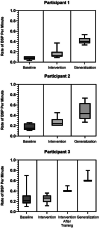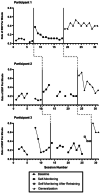Using Self-Monitoring to Increase Behavior Specific Praise in Elementary Classrooms
- PMID: 37680331
- PMCID: PMC10480120
- DOI: 10.1007/s40617-023-00810-3
Using Self-Monitoring to Increase Behavior Specific Praise in Elementary Classrooms
Abstract
Teachers need simple, easy to implement, evidence-based interventions to use in their classrooms. A single-case multiple baseline across participants design was used to determine if the use of self-monitoring in isolation would increase educators' use of behavior-specific praise (BSP). Participants tracked their use of BSP using a hand counter when they taught content area classes (i.e., science, social studies) and during a time of transition during the generalization phase. An increase in educators' rate of BSP was seen when self-monitoring was used. Data revealed that the rate of BSP per minute was higher during the generalization phase than the intervention phase. • Cost and time efficient way to: - Teach self-monitoring - Increase staff use of BSP - Generalize use of BSP.
Keywords: Behavior-specific praise; Elementary school; Self-monitoring.
© Association for Behavior Analysis International 2023. Springer Nature or its licensor (e.g. a society or other partner) holds exclusive rights to this article under a publishing agreement with the author(s) or other rightsholder(s); author self-archiving of the accepted manuscript version of this article is solely governed by the terms of such publishing agreement and applicable law.
Conflict of interest statement
Conflicts of InterestThe authors have no COIs.
Figures
References
-
- Amato-Zech NA, Hoff KE, Doepke KJ. Increasing on-task behavior in the classroom: Extension of self-monitoring strategies. Psychology in the Schools. 2006;43(2):211–221. doi: 10.1002/pits.20137. - DOI
-
- Cooper JO, Heron TE, Heward WL. Applied behavior analysis. Pearson/Merrill-Prentice Hall; 2020.
-
- Ennis RP, Royer DJ, Lane KL, Dunlap KD. Behavior-specific praise in pre-K–12 settings: Mapping the 50-year knowledge base. Behavioral Disorders. 2020;45(3):131–147. doi: 10.1177/0198742919843075. - DOI
-
- Hott BL, Berkeley SL, Raymond LP, Reid CC. Translating intervention research for students with mild disabilities to practice: A systematic journal analysis. Journal of Special Education. 2018;52(2):67–77. doi: 10.1177/0022466918759338. - DOI
-
- Hott BL, Walker JD, Brigham FJ. Implementing self-management strategies in the secondary classroom. In: Cohan A, Honingsfeld A, editors. Breaking the mold of classroom management: What educators should know and do to enable student success. R & L Education; 2014. pp. 19–26.
LinkOut - more resources
Full Text Sources



